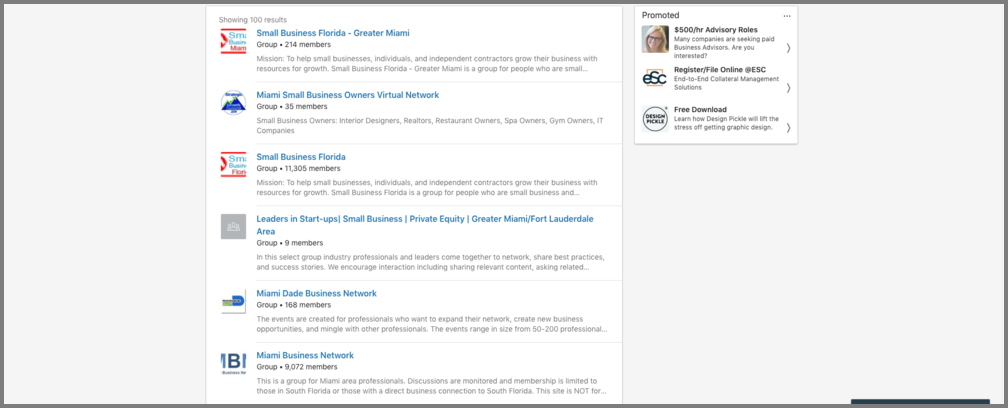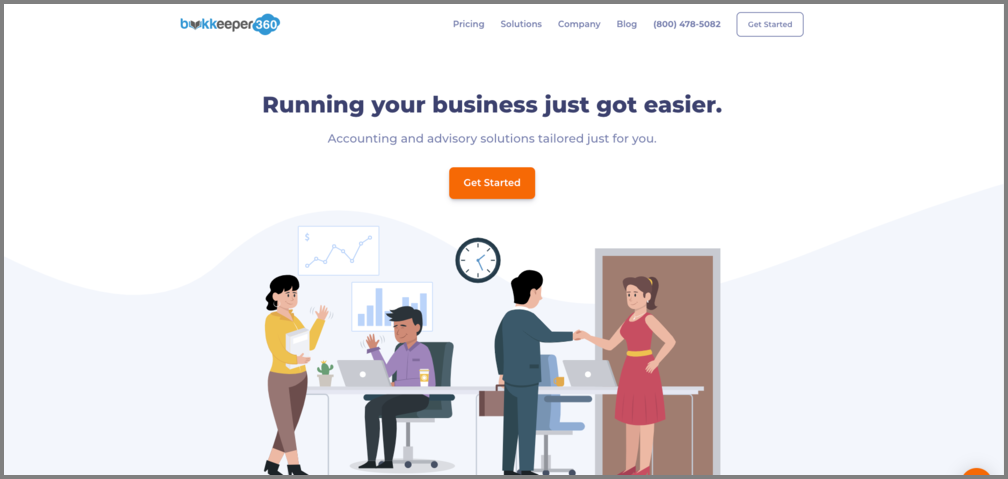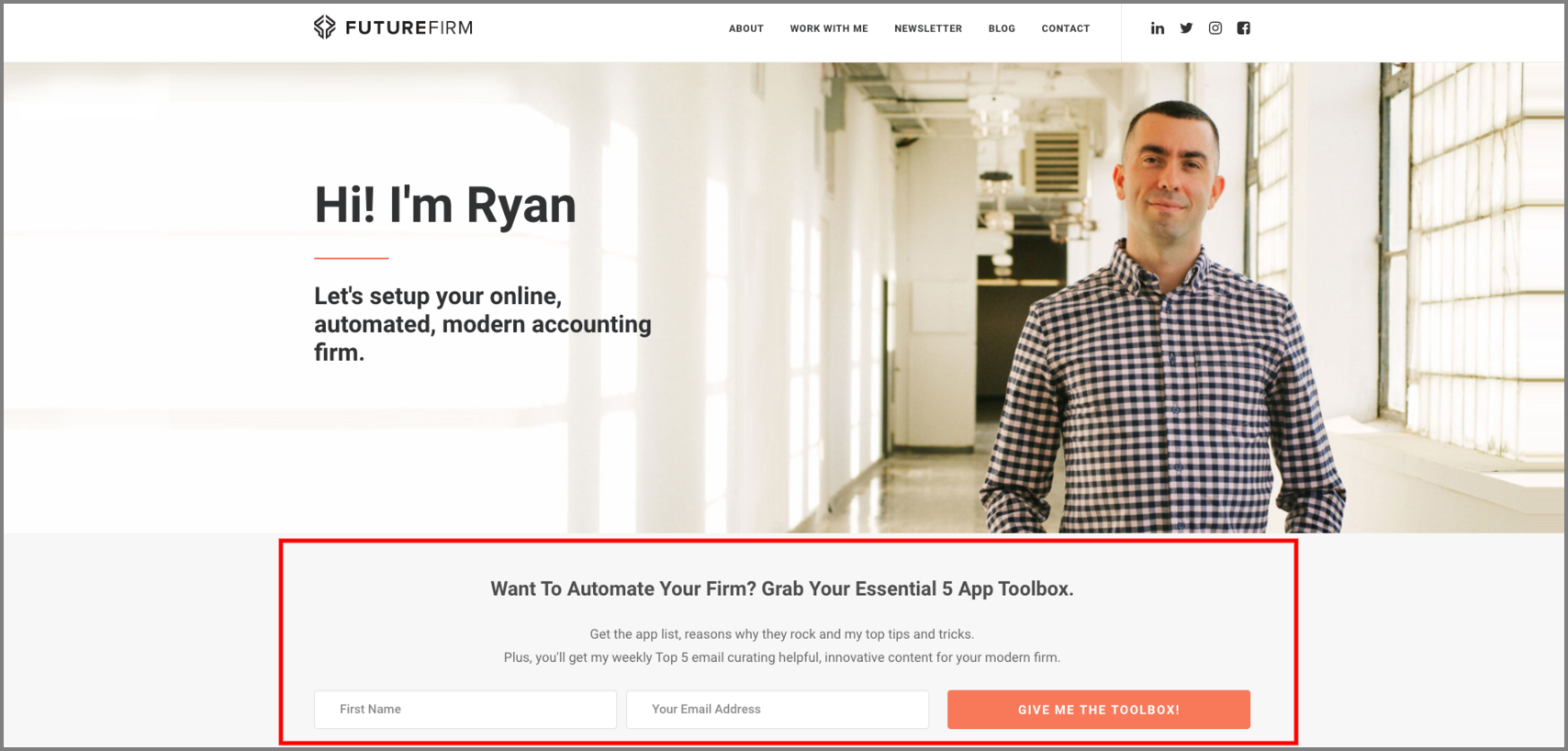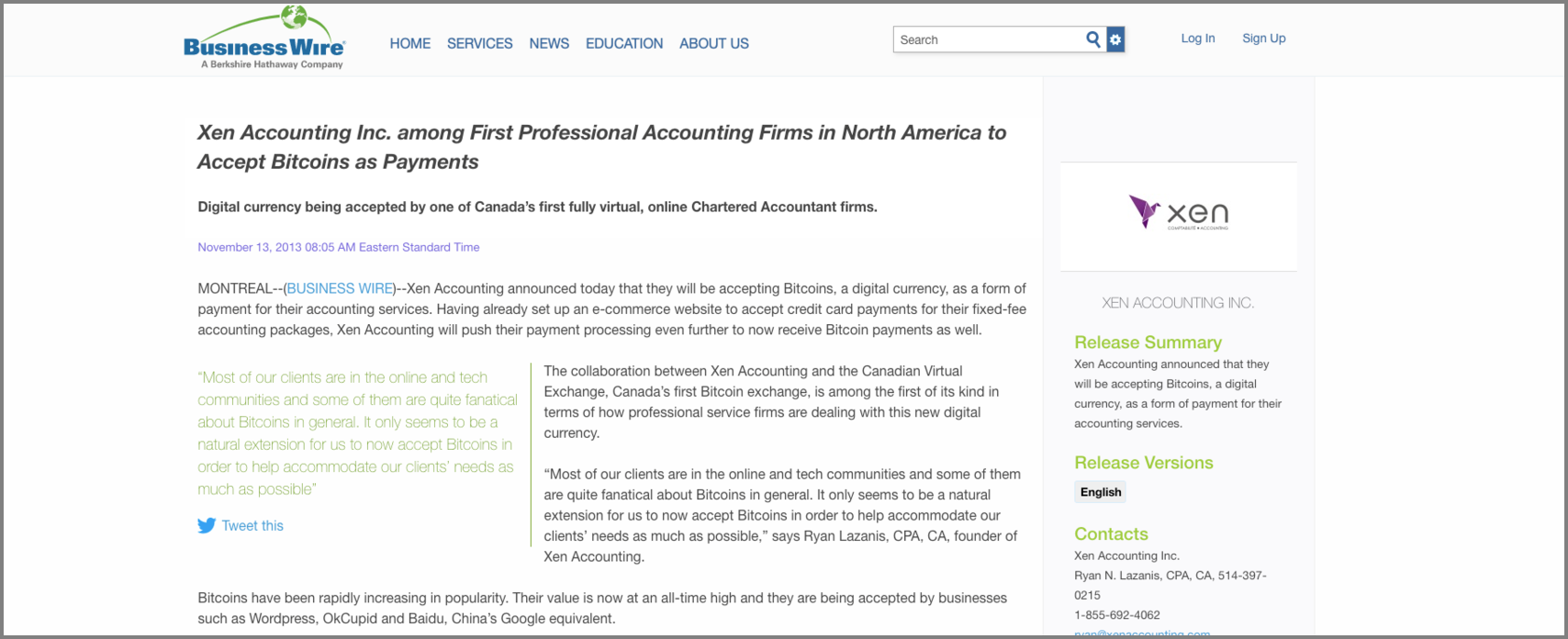Digital marketing for accountants in 2025 (13 proven tactics)
As a former cloud accounting firm owner who now helps accountants modernize their firms, I often get asked about the most effective tips on digital marketing for accountants. So I decided to write a post about my top 13 digital marketing for accountants tactics.

How do I know these techniques work?
Because I've used them all myself to help grow my former firm from scratch to sale in only five years. I've also successfully applied most of these tactics to my new venture, Future Firm.
The best part? They'll cost you little to no money.
So if you want to increase the number of inbound accounting leads you receive, read below for my 13 proven tactics on digital marketing for accountants.
Why digital marketing for accountants?
For too long, accountants have resorted to 2 methods for client acquisition:
Referrals
Local networking events
There is nothing wrong with these strategies. But they don't scale and client acquisition is unpredictable. If you can get your digital marketing working well, you'll get a constant flow of business online.
In fact, that's entirely how I grew my own firm, all without breaking the bank. Which is why I always recommend digital marketing for accountants.
Tactic #1: Optimize your blog posts for Search Engine Optimization (SEO)
When it comes to digital marketing for accountants, this is my #1 favorite tactic.
Your blog posts should be crafted in a way that maximizes your chances of hitting Google's first page for the topic that you're writing about. The result will be an increase in traffic to your website. A percentage of that traffic will ultimately convert into leads.
But if you don't optimize your blog post for SEO (Search Engine Optimization), it's highly likely you'll never make it to Google's first page. In fact, 90.63% of content gets no traffic from Google!
This is the biggest mistake that I see firms making with blogging. They publish content that will get no traffic from Google.
No traffic = no leads.
So how do you optimize your blog post for SEO to increase your chances of hitting Google's first page?
Below are 2 key steps, but if you're looking to acquire leads with your blog, download my 15-step blogging formula at the end of this article.
First, let's see the result of what a well-optimized blog post looks like:
My audience consists of accounting firms looking to modernize. So I wrote an article targeting the topic 'pricing accounting services' in a post titled, Guide to Pricing Accounting Services. As you can see from the below Google search, you'll find my article showing as the first search result at the time of writing.

This means that I get continuous traffic to my website through this one blog post whenever someone types in "pricing accounting services" in Google.
Below are two quick tips to help ensure that your blog generates leads (and download my full 15-Step Blogging Formula to acquiring tons of leads from your blog at the end of this article):
Blogging quick tip 1
Identify the challenges your ideal clients are having. Your blog post will serve as a way to solve these problems. Think about what your ideal client would type into Google to get their answer. This will help form your topic. Write down a few topic ideas based on this.
Blogging quick tip 2
What your ideal client is typing into Google to solve their challenge is considered a keyword. For instance, if they want to know about upcoming tax filing deadlines, they may type, "tax filing deadline" in Google to get their answer.
So head on over to a keyword research tool to validate a few things (Ubersuggest is free).
Just type in your keyword and you'll get info on monthly search volume and how easy it is to rank for that keyword (ie. SEO Difficulty score). These aren't 100% accurate and should be used as a high-level guide, but you're looking for some volume and a low difficulty score.
Here's an example for the keyword "tax filing deadline":

There's excellent monthly search volume for that keyword, but newer blogs will want to target the lowest SEO difficulty possible to increase your chances of hitting Google's first page.
So scroll down the results page a bit and you'll get some alternate keyword suggestions:

Here we have plenty of keyword options with very low difficulty, so I would target some of those.
You don't need a ton of volume. Even if something has 20 hits a month, you're fine. And if you pick something with a low difficulty score, you'll have an easier time getting on Google's first page to drive some traffic to your blog.
If you can get those two things right, you're already well ahead of most firms that are blogging.
Reminder: For my full 15-Step Blogging Formula to acquiring tons of leads through your blog, download it at the end of this post.
Tactic #2: Update your LinkedIn profile
This is what I would consider pretty basic digital marketing for accountants. Nothing fancy here, but many accountants have profiles that need some serious updating.
People will find you on LinkedIn and they will connect with you. This is an easy way to build out your network in the online world. So make sure your profile is regularly updated.
A few things to consider:
Upload a high-quality, professional-looking photo of yourself
Complete your about section outlining who you are as a person. I typically prefer to write in the first person to make it a bit more personable and to show off my personality (for better or worse!)
Make sure your experience section is up to date and that you provide a brief description of what you do and who you help
Tactic #3: Join LinkedIn groups in your niche
If you want an easy way to build up your network, there's no easier way than to join a few LinkedIn groups in your target market.
For instance, let's say you have a regional firm in Miami and you want to target small businesses in that area.
Head on over to LinkedIn and do a search for "miami small business". Then filter by groups.
And voila.

Join these groups and then contribute regularly. You'll build some good connections.
Do not spam or promote yourself! You will get kicked out (I've learned this the hard way early on).
Tactic #4: Post 2-3 times per week on Linkedin using hashtags
Now that you have an updated profile on LinkedIn and you have built some connections in your target market through LinkedIn groups, it's time to start getting your brand out there a bit.
On your personal LinkedIn page, I suggest posting useful, relevant content to your target audience a few times a week, every week. This is not a time to advertise your services. This is a time to share valuable information related to the challenges and problems of your target market.
It doesn't have to be always original content either. For instance, if you see an article on a new tax law, share it on LinkedIn and give your two cents. Or, you can open the floor to questions to get your audience talking about topics of interest to them.
Lastly, I recommend adding hashtags to the end of your posts. Hashtags just summarize the topics in the post.
At times, you'll have posts that are well-received and you can get them trending on LinkedIn.

And the reward for getting your post trending on LinkedIn is that it's now shown to a much wider audience.

One caveat: Your target market may not actually reside on LinkedIn. As such, the above strategies on LinkedIn may not be your best course of action when it comes to social media.
Tactic #5: Include a call-to-action on your website homepage
Your website should be designed to do one thing: turn visitors into leads. Most accounting firm websites do a terrible job with this.
The simplest way is to include a few basic calls-to-action (CTA) on your homepage. A CTA is basically something that you're asking your website visitor to do.
Whether it be to fill out a form or to schedule a meeting, you should have a few buttons on your homepage that ask your visitors to do something to take the sales process to the next step.
Here's a good example:

Notice how there are a few big bright buttons smack dab on the homepage asking you to do something? And if you scroll down, these buttons are littered everywhere on the page.
For now, you don't need anything fancy. It can just be a "schedule a meeting" button or something like that. As you progress, you can get a bit fancier.
Tactic #6: Capture email addresses with a lead magnet
This one is a bit more technical, but if done right, you can reap big rewards.
A lead magnet is something of value that you provide to your website visitors in exchange for their email address. That email address can then be used to promote yourself via your newsletter, which we'll go into later.
A lead magnet should have a catchy title and should include content that specifically solves a problem that your target market is seeking a solution to. Types of lead magnets can be guides, toolkits, cheat sheets, reports, ebooks, case studies, etc.
There are a few places to include lead magnets on your website.
First, you can include them on some of your blog posts. They can be a form in the middle or end of your posts. They can even be pop-ups (which can be annoying at times).
If you're curious to see an example, just head to the bottom of this post where you can download my 15-Step Blogging Formula to acquire tons of leads with your blog.
Another place where you can include them is front and center of your home page like I do with my company, Future Firm:

This works great if you have a good topic and the right messaging. For instance, close to 10% of visitors to my site are providing their email addresses using the lead magnet above.
Alternatively, lead magnets can pop-up on a visitor's screen based on certain criteria. For example, if you go to this post of mine, you'll notice that once you try to exit the page, you'll be prompted with a pop-up on your screen to provide your email address to download my lead magnet.
Tactic #7: Create Youtube videos around content your audience is searching for
Youtube is massive. So if you create some videos that solve some of your target market's problems, you could see some good traffic coming from it.
Like tactic #1, you should ensure that you are optimizing the content in a way that can be easily found on Youtube. If you use the wrong keywords, it's possible that your videos just get buried in the millions of other videos on the platform.
Here's an example of a video that I created 5 years ago on the topic of Receipt Bank integration with Xero with my previous firm, which has generated 20k+ plus views to date. Views can turn to leads!

Tactic #8 - Start a Podcast
Many accounting firms are not utilizing this medium to acquire business, though I think it can be an effective, inexpensive one.
One example of a firm doing a good job here is Kruze. They target tech startups, so their COO started a podcast called Founders & Friends interviewing tech startups.
This is great because it puts you in contact directly with the people you're trying to sell to and also builds up your brand in that niche.
If you're interested in learning more about podcasting for your firm, I invited David Leary and Blake Oliver, co-hosts of the Cloud Accounting Podcast, on to my podcast to speak about how firms can get started.
When it comes to digital marketing for accountants, this is an excellent low-cost option.
Tactic #9: Host webinars
Your target market usually has the same kind of problems and challenges. Presenting on a solution to those challenges via a webinar is a great way to attract new leads into the fold.
Karbon does a great job at this. They often put out high-quality webinars that deliver solutions to their audience's problems.
Not only does it strengthen their existing customer base, but it brings in new leads as well. All new leads are (I imagine) added to their newsletter to be able to get in front of this audience consistently.
The toughest part is obviously getting people to your webinar. A simple way to start is to invite your current clients and ask them to invite people who they think would be interested as well. On top of that, you can promote it on your social media pages as well as on LinkedIn groups that you're a part of.
Tactic #10: Send a regular newsletter
This is something I wish I started years ago—it has been groundbreaking for me.
A regular newsletter allows you to get in front of your audience often and it helps create and foster strong relationships if done right.
And when you have new services to offer, you can simply mention it in your newsletter and I guarantee that you'll get some hits from it. You can start by adding your current clients to the list. Some of the strategies listed in this article will also help grow your subscriber base.
If you want an effective newsletter, I can recommend the following tips:
Consistency is key
Your readers need to know when they'll be getting your newsletter. Develop a habit around sending your newsletter out at the precise same day and time each and every time.
Pick a theme
Again, your readers need to know what they're getting each and every time they get your newsletter.
On my end, I chose a simple Top 5 theme. Each week I send firm leaders a brief email highlighting the top 5 pieces of content that I've found that helps their firms modernize. So each week, my readers know exactly what they'll be getting.
If you want to see an example of one of my newsletters, check the link at the bottom of this page.
Give value
This is the final and most important point. If you treat your newsletter like one big advertisement for your firm, it will go nowhere! No one wants another email in their inbox. If you're sending out an email, make sure the content that you're providing has value.
Finally, there are some anti-spam laws that you may want to read about to ensure that you're in conformity.
Tactic #11: Create a Facebook group for your target market
There's a good chance that you're on Facebook. There's also a high likelihood that you're a part of at least one Facebook group.
People are interested in joining communities where they can get valuable information. So why not create your own?
Again, I take a keyword-oriented approach, but it's not critical. Why?
if you're looking to join a local Montreal small business group, you'll type in something like "Montreal small business"
So you can create a group around this kind of keyword, invite your current clients in and even without any promotion, you'll get others searching for those kinds of groups joining.
The important part is to provide your members with useful info and content regularly to keep them engaged.
Tactic #12: Create a viral press release
This one is a bit gimmicky and is tough to hit. But if you do, watch out, because the leads will be hitting you in the face.
I released my first press release online back in 2013. I had just started my firm where I was initially targeting technology companies.
And at that time, Bitcoin went from a few dollars to over a thousand dollars. So there was a lot of buzz.
So I released the following press release:

And this simple press release generated a ton of buzz at the time. I was interviewed for various news outlets, I was featured on many websites and I got a bunch of leads.
In terms of digital marketing for accountants, be prepared for this tactic to flop. I had a few after that which went nowhere.
Tactic #13: Ditch paid ads
My final strategy is not really a strategy at all. It's actually something that I would recommend avoiding for most firms.
Paid ads are expensive and the results I've seen, for the most part, have not been very effective.
I'm not saying that Google Ads or Facebook Ads won't work. If you get someone that knows what they're doing to manage them and you're willing to invest a good amount of money (thousands per month over a decent period of time), then I think you can turn an ROI, but most firms I'm seeing are either managing the ads themselves, only running them for a few months or not spending enough budget.
Paid ads are a great way to get instant traffic, but you have to be prepared to invest.
If you go this route, get someone that really knows what they're doing.
Want to acquire tons of leads with your blog?
My top lead acquisition strategy for my firm has been blogging. In fact, I built two businesses entirely off of blogging.
And good news, you can download my exact 15 Step Blogging Formula to acquire tons of leads with your blog below.
Download the 15-Step Blogging Formula.

